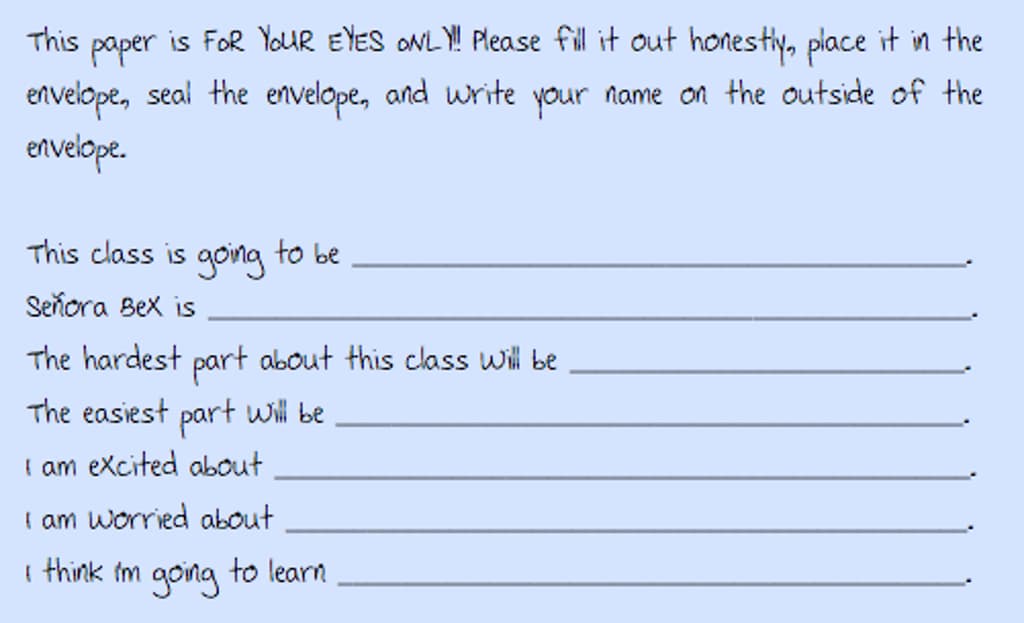Have you ever made a time capsule? I never made one intentionally, but there was this small space between my classroom cabinets and the wall that I was not aware of until student projects started disappearing from on top of the cabinets...I tried everything to pull them back out of that 8' deep hole, but in the end determined that it would just have to wait for the school to be demolished in another 200 years.
The closest that I've come to an intentional time capsule is writing a letter to myself as part of some life-changing activity. Like when I left Mexico after a summer internship in Oaxaca with Global Frontier Missions (now based in Atlanta), or at the end of the HOBY conference that I attended in my sophomore year of high school. My husband had to write one last year at the end of his BOLD course for Keller Williams. The premise for all of these was the same: we learned a lot, grew a lot as a person, and set goals for the future. We wrote letters to ourselves that some head of the organization mailed to us 6 months or 1 year in the future as a form of accountability and a reminder about the goals that we set.

I usually do something similar at the beginning of the school year with my students--instead of setting goals, however, they make predictions (see image). They do this at the end of the first day of classes or at the beginning of Day 2, and then I save the sealed envelopes until the end of the school year. On the last day of class, I give back their envelope to them, and they usually have a good laugh at how the class ended up comparing to their expectations after that first day or two.
Well that's all fine and dandy, but you probably have enough to do on the first day of school. (If you don't, check out my First Days tag archive.) This post is about using the "Time Capsule Predictions" as an activity for novels! It occurred to me as I was reading the first chapter of Mira Canion's latest novel, Fiesta Fatal. The first chapter makes it clear that there is going to be some drama in the novel, and I thought that it would be fun to see what each student thinks will transpire from it and then compare it to how the story actually ends. While you could use this for any novel, I think that it is best to save it for the ones that present several different, very dramatic conflicts in the first chapter. Another novel that immediately comes to mind is La Calaca Alegre by Carrie Toth (BTW, if I were forced to choose a favorite class novel, La Calaca Alegre would be it...which is really saying something because there are so many others that I absolutely loved reading and teaching...like Esperanza and El Nuevo Houdini). Anyway, I wouldn't recommend doing this for every novel that you read because it will quickly become monotonous.
Here's how to do it:
- Read the chapter with students, in any way that you want. Read it once, twice, three times...it doesn't matter. Just read it.
- Analyze the conflicts, both internal and external. Discuss character flaws, conflicts between characters, unsolved mysteries, anything! Discuss them as a class, and then make a list that summarizes each one. (All of this in the target language, of course, using your TPRS®/CI strategies to keep it comprehensible...!)
- Give each student a piece of paper and require everyone to write a sentence for each conflict that predicts how it will be resolved. For example, if the conflict is "Brandon doesn't have a dog", the prediction might be "Brandon is going to save money until he is able to buy one". If the conflict is, "Brandon thinks that his sister's rat is horrible", the prediction might be "Brandon is going to cut his sister's rat in half with a kitchen knife". (I only write that because you know that one of your students always goes there...both of those examples are from Brandon Brown quiere un perro.)
- Make sure that each student wrote his/her name on the paper, then collect them and keep them in a safe place until you're done reading the novel. DO NOT LOSE THEM! I make a box for each class novel that we read (I just grab empty paper boxes from the copy room), and this would be a perfect place to stash the letters for the duration of the unit. I keep my lesson plan binder for the novel, the novels (when they're not in use), and any reusable activities that I've made for the novels in the box. That way, I have everything stored neatly and together, ready and waiting for me when I'm ready to teach it next.
- After you've finished the novel, pull out the letters and hand them back to students. Share them with the class, and discuss how they compare to what actually happened.
Simple simple! No prep required and no photocopies needed--just some lined paper. I predict that you'll love it :)




